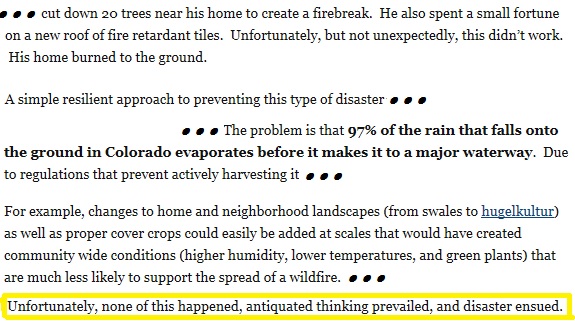Below are some quotes from a recent newsletter I get. One reason why I get this newsletter is the gentleman in question has some really great pieces & information that he does provide. Unfortunately in this case, whether it was because of target fixation, his never experiencing one, or his just plain not knowing any better about the causes, effects, etc… he really missed the mark.

 Note: as a general rule we do not link to pieces or pictures of bad practices so as not to embarrass some of them & also because we don’t want Google thinking that just might be a good piece. In this case I am going to provide a link to the site (see below in “A simple…”) as he does have some great pieces & to be honest, well we all have some not so greatly written pieces or for better lack of a term, the occasional brain fart. Note: as a general rule we do not link to pieces or pictures of bad practices so as not to embarrass some of them & also because we don’t want Google thinking that just might be a good piece. In this case I am going to provide a link to the site (see below in “A simple…”) as he does have some great pieces & to be honest, well we all have some not so greatly written pieces or for better lack of a term, the occasional brain fart. |
Unfortunately but not unexpectedly?
As Paul Harvey was fond of saying, and now for the rest of the story… The example he quoted above comes from an Associated Press piece about Nigel Thompson who lived in the Black Forest community & lost his million dollar home. What got left off was that he goes on to say – “If you’re surrounded by people who haven’t done anything, it doesn’t matter what you do,” Thompson said. “It’s interesting that you can have a house in a forest and the building code doesn’t say anything about the roof design.”
While I have not seen the house in question or how closely they are bunched together, it sounds like Mr. Thompson did follow at least some of the “Firewise” advice, but unfortunately his neighbor did not. It also sounds like an ember from somewhere managed to get past his roofing (probably through a vent or it got stuck in some leaves trapped in a roof valley) allowing what was underneath to catch on fire. Once that happened, well it was unfortunately game over. As for the codes, well…
A simple…
In case you can’t tell the main focus of this piece & his site is about resiliency & in particular resilient communities. I am sure John will probably agree with me that nothing is really simple, or we would have been doing it all along. Of course in many cases some might just consider the practices “antiquated thinking.”
97%?
You remember the game where one person would start by whispering something in one person’s ear, and by the time it reached the end of the line it wouldn’t even resemble the original? Well unfortunately that is what happened here & happens quite often on the internet to keep tweets or pieces shorter. The actual study (which was being used trying to get Rainwater harvesting allowed in Colorado) found that 97% of the water never reached the streams – it didn’t simply evaporate, but it was soaked up by trees, crops, went into aquifers & yes some even evaporated. As for the accuracy or validity of those numbers, well…
 As a big fan of rainwater harvesting I also would like to see Colorado allow for more of this though there are some potential issues. As it applies to forest fires though, most homeowners would not be able to capture or store enough rain water to help save their houses. The biggest issue has to deal with time – in some cases you have 3 hours up to a few days’ notice to evacuate – just how do you ensure that the water will be on just before the embers can reach your house & when it has it surrounded (assuming it does)? As a big fan of rainwater harvesting I also would like to see Colorado allow for more of this though there are some potential issues. As it applies to forest fires though, most homeowners would not be able to capture or store enough rain water to help save their houses. The biggest issue has to deal with time – in some cases you have 3 hours up to a few days’ notice to evacuate – just how do you ensure that the water will be on just before the embers can reach your house & when it has it surrounded (assuming it does)? |
Cover crops & a what?
Cover crops, I like that term – of course fire fighters have another term for it which is “fuel (for the fire)” & occasionally “ladder fuel” (e.g. an item which allows the fire to climb from the ground up into the tree canopy, your house, or elsewhere). A HugelKultur essentially is essentially burying dead wood to help invigorate the soil. Well first off the soil isn’t the issue here; it is the location, forestry practices, and climate. The other issue with this & swales is once again fire likes to climb and now you have provided a nice launching place for embers & a place of protection.
Preventing disaster:
 Seeing everyone is always looking for a simple solution, I actually have one for you & it is you. You need to stop relying on codes to protect you. Codes are only minimums meant to keep one safe in a typical setting. You can’t rely on others to do what they are supposed to do, so it helps if you plan accordingly. It also doesn’t matter if you help do everything to make a community resilient if you haven’t taken care of your needs also. (i.e. Don’t be the weakest link in the chain) As the saying goes, only you can prevent…
Seeing everyone is always looking for a simple solution, I actually have one for you & it is you. You need to stop relying on codes to protect you. Codes are only minimums meant to keep one safe in a typical setting. You can’t rely on others to do what they are supposed to do, so it helps if you plan accordingly. It also doesn’t matter if you help do everything to make a community resilient if you haven’t taken care of your needs also. (i.e. Don’t be the weakest link in the chain) As the saying goes, only you can prevent…
 While local jurisdictions can fine tune codes to their area, between special interests, politics & a host of other issues very few areas are up to date & much less . As one of the deck builders who works in that area pointed out, after the fires not so long ago the general consensus was “never again.” Well unfortunately never again has stricken again and instead of non-combustible materials being standard, they are still an “option.” While local jurisdictions can fine tune codes to their area, between special interests, politics & a host of other issues very few areas are up to date & much less . As one of the deck builders who works in that area pointed out, after the fires not so long ago the general consensus was “never again.” Well unfortunately never again has stricken again and instead of non-combustible materials being standard, they are still an “option.” So it is a wise individual who will listen to such options and decide for themselves if it is worth it. If also helps if you check out programs that apply to areas like yours (Fortified Buildings, FireWise, FEMA, etc…) to help make better informed decisions. So it is a wise individual who will listen to such options and decide for themselves if it is worth it. If also helps if you check out programs that apply to areas like yours (Fortified Buildings, FireWise, FEMA, etc…) to help make better informed decisions. |

Glad you mentioned venting the attic. It plays an important role in burning your house down during a wildfire or when your neighbor’s home is on fire. Dr. Joe covered this recently in his article, Rocks Don’t Burn. http://www.buildingscience.com/documents/insights/bsi068_rocks_dont_burn
Glad you mentioned venting the attic. It plays an important role in burning your house down during a wildfire or when your neighbor’s home is on fire. Dr. Joe covered this recently in his article, Rocks Don’t Burn. http://www.buildingscience.com/documents/insights/bsi068_rocks_dont_burn